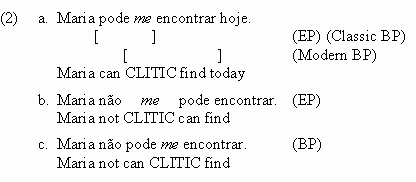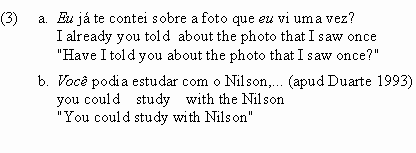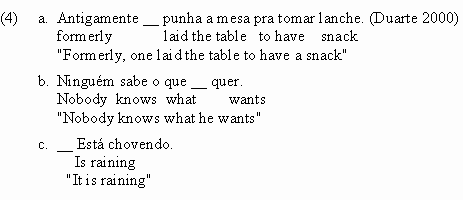The correlation between NS and inversion has been challenged by Safir (1982), who found out that Northern Italian dialects, while disallowing the former, license the latter. In our project, we found out that BP has been exhibiting a change in progress in both properties [a] and [b], a fact that can be used in favor of a single parameter (cf. Tarallo / Kato 1989, Duarte 1993, Roberts 1993).
Duarte (1993/2000) shows that from a preference of null subjects in 80% of cases in the middle of the 19th century, the situation is found reversed in the end of the 20th century, namely a little more than 20%, a clear indication of a change in progress. As for VS order, Torres Morais (1993) finds that from the beginning of the 19th century to the present date, the XVS form in declaratives decreases from 20% to 0%, while the VSX, which was already rare in the 19th century (6%), becomes totally absent in modern plays. Andrade Berlinck (1995) shows that VS is possible, though, with unaccusative verbs. Lopes-Rossi (1993), on the other hand, shows the decrease of VS order in interrogatives, with an increase of cleft-interrogatives (37,6%) (example (1)a) and in-situ questions (32,4%) (example 1b), both of which require SV order.

The theory of parameters provides us with another correlation which has not been much explored, namely the fact that NS languages have clitic climbing (Kayne 1989). In our project Pagotto (1993) and Cyrino (1993), studying the position of clitics in the history of BP, finds that, like present day EP, the clitic in classic BP root clauses used to be enclitic to the finite verb, while in Modern BP it is proclitic to the main verb.5 In other words BP corroborates Kayne's theory, considering that it is also loosing the NS property, as pointed out by Roberts (1993) .

Though the empirical results corroborate the three properties (null subjects, VOS order and clitic climbing) as part of the same parameter, the facts regarding Brazilian Portuguese also present challenging problems for the theory of parameters. Thus, though Duarte (1993) and (2000) show a significant decrease in the use of null subjects,6 they show that the change affected mainly the first and second persons, leaving a still reasonably stable use of null subjects in the third person, specially the non-referential ones.








